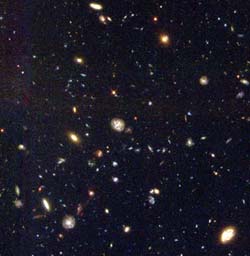New theory finds middle ground between conflicting evidence for first stars

The very first stars that formed early in the history of the universe were smaller than the massive giants implied by the results of a NASA research satellite, but still larger than the typical stars found in our galaxy today, according to a research team led by the University of Chicago’s Jason Tumlinson.
“We have managed to reconcile within a single theory the two very different leading indicators of the nature of the first stars,” said Tumlinson, the Edwin Hubble Scientist in Astronomy & Astrophysics at the University of Chicago. Tumlinson will present the theory June 1 at the American Astronomical Society meeting in Denver. His co-authors are the University of Colorado’s Aparna Venkatesan and J. Michael Shull.
No telescope is powerful enough yet to see the first stars, but astronomers can guess at their existence based on the stellar clues they leave behind. In 2001 and 2002, NASA’s Wilkinson Microwave Anistropy Probe (WMAP) looked at the oldest light in the universe left over from the big bang, the cosmic microwave background, and found one such clue in the form of ionized (electrically charged) gas floating between the galaxies. WMAP showed that this intergalactic gas was ionized approximately 200 million years after the big bang.
“Very massive stars, with roughly 200 to 500 times the mass of the sun, and more massive than we see anywhere today, are extremely efficient at producing this ionizing radiation,” Tumlinson said. This implies that the earliest stars were massive enough to cause the ionization.
But the oldest stars in our galaxy that astronomers can see in the sky today are on average approximately 13 billion years old. “They would have formed just after the first stars and out of the very gas and heavy elements that were strewn into space when the earliest stars exploded as supernovae,” said Venkatesan, a National Science Foundation Fellow at Colorado and 2000 University of Chicago Ph.D. alumna.
The problem is that the ratio of heavy elements observed in the second generation of stars could not have been produced in the most massive stars associated with the WMAP studies.
“It was our goal to reconcile these two conflicting pieces of evidence,” Tumlinson said.
His team reconciled the evidence by formulating a theory showing how stars with a mass of 20 to 100 times that of the sun could both be large enough to satisfy the WMAP results, yet still produce the ratio of heavy elements detected by ground-based telescopes in very old stars.
“We’re not saying the very massive stars couldn’t have formed at some low level. We’re saying that for early heavy element production you need mostly stars that are massive but not extremely massive.”
This theory meshes well with what astronomers know about how stars of various masses form in the galaxy.
“There are a lot of very low-mass stars like the sun, and as you go up in stellar mass, the numbers get more rare,” Tumlinson said. “There are a very few stars of high mass, say a hundred solar masses in our galaxy. According to our theory, these massive stars were much more common in the first generation.”
Problems that remain to be solved include determining how long the conditions could be maintained for forming the first stars from primordial gas and how these objects can be detected in the future, Venkatesan said.
“Predicting how the first stars affect their environment and whether they resemble the stars in our own galactic backyard at all is a critical input for the planning of future telescopes and instruments and in interpreting their data,” she said.
The project was funded by NASA and the National Science Foundation.
Media Contact
More Information:
http://astro.uchicago.edu/All latest news from the category: Physics and Astronomy
This area deals with the fundamental laws and building blocks of nature and how they interact, the properties and the behavior of matter, and research into space and time and their structures.
innovations-report provides in-depth reports and articles on subjects such as astrophysics, laser technologies, nuclear, quantum, particle and solid-state physics, nanotechnologies, planetary research and findings (Mars, Venus) and developments related to the Hubble Telescope.
Newest articles

More efficient car designs with AI
8,000 open source models for sustainable mobility. Designing new cars is expensive and time consuming. As a result, manufacturers tend to make only minor changes from one model generation to…

The new Polarstern: Contract for new German research icebreaker awarded
Good news for the German research fleet, German shipbuilding, and international polar research alike: the new Polarstern will be constructed in Wismar by thyssenkrupp Marine Systems. The company received the…

Colored nuclei reveal cellular key genes
The identification of genes involved in diseases is one of the major challenges of biomedical research. Researchers at the University of Bonn and the University Hospital Bonn (UKB) have developed…


